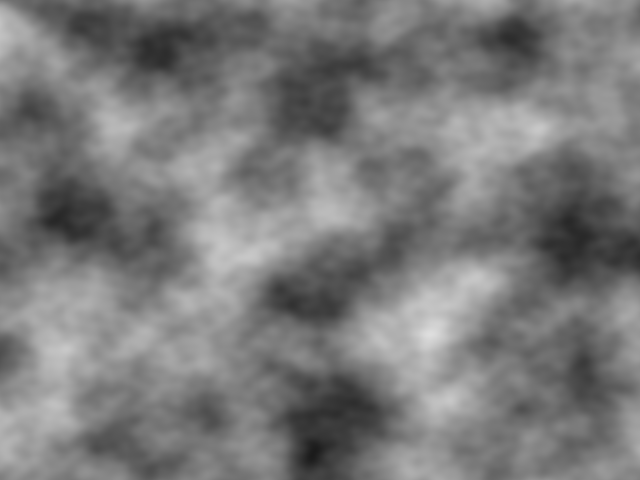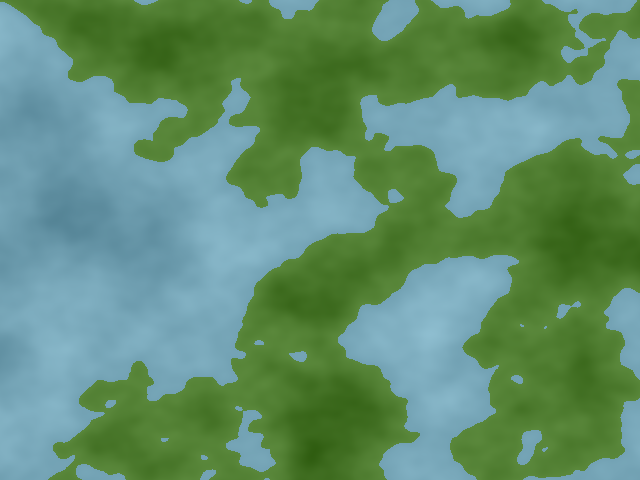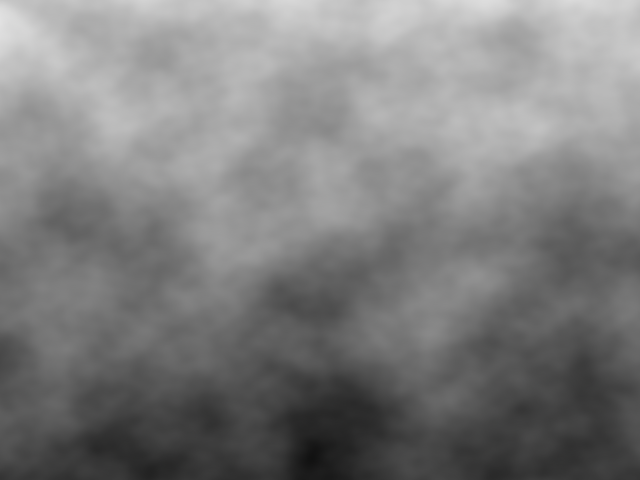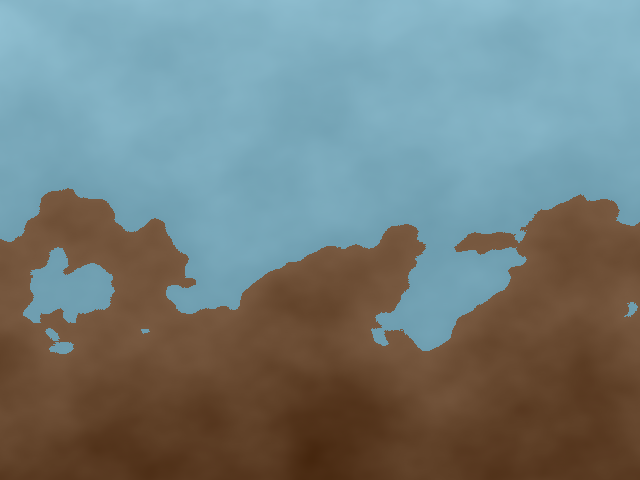

A perlin noise function is a function that will take coordinates and give you a single value, the value of the noise at that point.
Assuming you have a working perlin noise function at your disposal, let us try to make some primitive terrain into 3D voxel space with it, quite like what is used in Minetest or Minecraft.

That is an image of 2D perlin noise. Every point of it in the 2D plane has an intensity value, determined by the noise function. We will think of that as a slice of 3D noise, so that upwards in that image is towards the sky in the 3D world. The 3D perlin noise has a nicely but randomly changing value in 3D space, to all directions.
Now, how could we use this to separate ground from air? Let's take a threshold level of intensity and set the darker parts to be ground and the brighter parts to be air.

This is what you would want if you were using the 2D noise value to set up the height of the ground, and that would be what you would see looking from the top, the blue stuff being water. That is not what we are doing here.
From our perspective this doesn't look quite right. Remember, it is a slice of 3D noise, top of image is top of world. There is ground at the top of the world and sky at the bottom of the world. There is no "ground level", the world just consists of random parts of ground and air.
The solution is very simple. We will subtract the value of the height of every point from the value of the noise. This creates a noisy gradient, like this:

This actually isn't a subtraction, but rather a mix with a gradient. But that is good enough for us now.
We then set up a threshold in this 2D slice of the 3D function, just like before. We now have a slice of the world that looks like this:

To make it more interesting, it is possible to set up traditional heightmap-style 2D noises to control the multiplier of the height subtraction and the parameters of the 3D noise function (amplitude and persistence).
This, combined with choosing a water level and replacing air with water, replacing top of the ground with grass, adding trees, caves and so on is what currently makes up the Minetest world.
-celeron55, 2011-07
Oct 5 2011 EDIT: Oh, and just for some more completeness, here's the copy pasted perlin noise code from Minetest. License is GPLv2:
// noise.h
double easeCurve(double t);
// Return value: -1 ... 1
double noise2d(int x, int y, int seed);
double noise3d(int x, int y, int z, int seed);
double noise2d_gradient(double x, double y, int seed);
double noise3d_gradient(double x, double y, double z, int seed);
double noise2d_perlin(double x, double y, int seed,
int octaves, double persistence);
double noise2d_perlin_abs(double x, double y, int seed,
int octaves, double persistence);
double noise3d_perlin(double x, double y, double z, int seed,
int octaves, double persistence);
double noise3d_perlin_abs(double x, double y, double z, int seed,
int octaves, double persistence);
// noise.cpp
#define NOISE_MAGIC_X 1619
#define NOISE_MAGIC_Y 31337
#define NOISE_MAGIC_Z 52591
#define NOISE_MAGIC_SEED 1013
double cos_lookup[16] = {
1.0,0.9238,0.7071,0.3826,0,-0.3826,-0.7071,-0.9238,
1.0,-0.9238,-0.7071,-0.3826,0,0.3826,0.7071,0.9238
};
double dotProduct(double vx, double vy, double wx, double wy){
return vx*wx+vy*wy;
}
double easeCurve(double t){
return 6*pow(t,5)-15*pow(t,4)+10*pow(t,3);
}
double linearInterpolation(double x0, double x1, double t){
return x0+(x1-x0)*t;
}
double biLinearInterpolation(double x0y0, double x1y0, double x0y1, double x1y1, double x, double y){
double tx = easeCurve(x);
double ty = easeCurve(y);
/*double tx = x;
double ty = y;*/
double u = linearInterpolation(x0y0,x1y0,tx);
double v = linearInterpolation(x0y1,x1y1,tx);
return linearInterpolation(u,v,ty);
}
double triLinearInterpolation(
double v000, double v100, double v010, double v110,
double v001, double v101, double v011, double v111,
double x, double y, double z)
{
/*double tx = easeCurve(x);
double ty = easeCurve(y);
double tz = easeCurve(z);*/
double tx = x;
double ty = y;
double tz = z;
return(
v000*(1-tx)*(1-ty)*(1-tz) +
v100*tx*(1-ty)*(1-tz) +
v010*(1-tx)*ty*(1-tz) +
v110*tx*ty*(1-tz) +
v001*(1-tx)*(1-ty)*tz +
v101*tx*(1-ty)*tz +
v011*(1-tx)*ty*tz +
v111*tx*ty*tz
);
}
double noise2d(int x, int y, int seed)
{
int n = (NOISE_MAGIC_X * x + NOISE_MAGIC_Y * y
+ NOISE_MAGIC_SEED * seed) & 0x7fffffff;
n = (n>>13)^n;
n = (n * (n*n*60493+19990303) + 1376312589) & 0x7fffffff;
return 1.0 - (double)n/1073741824;
}
double noise3d(int x, int y, int z, int seed)
{
int n = (NOISE_MAGIC_X * x + NOISE_MAGIC_Y * y + NOISE_MAGIC_Z * z
+ NOISE_MAGIC_SEED * seed) & 0x7fffffff;
n = (n>>13)^n;
n = (n * (n*n*60493+19990303) + 1376312589) & 0x7fffffff;
return 1.0 - (double)n/1073741824;
}
double noise2d_gradient(double x, double y, int seed)
{
// Calculate the integer coordinates
int x0 = (x > 0.0 ? (int)x : (int)x - 1);
int y0 = (y > 0.0 ? (int)y : (int)y - 1);
// Calculate the remaining part of the coordinates
double xl = x - (double)x0;
double yl = y - (double)y0;
// Get values for corners of cube
double v00 = noise2d(x0, y0, seed);
double v10 = noise2d(x0+1, y0, seed);
double v01 = noise2d(x0, y0+1, seed);
double v11 = noise2d(x0+1, y0+1, seed);
// Interpolate
return biLinearInterpolation(v00,v10,v01,v11,xl,yl);
}
double noise3d_gradient(double x, double y, double z, int seed)
{
// Calculate the integer coordinates
int x0 = (x > 0.0 ? (int)x : (int)x - 1);
int y0 = (y > 0.0 ? (int)y : (int)y - 1);
int z0 = (z > 0.0 ? (int)z : (int)z - 1);
// Calculate the remaining part of the coordinates
double xl = x - (double)x0;
double yl = y - (double)y0;
double zl = z - (double)z0;
// Get values for corners of cube
double v000 = noise3d(x0, y0, z0, seed);
double v100 = noise3d(x0+1, y0, z0, seed);
double v010 = noise3d(x0, y0+1, z0, seed);
double v110 = noise3d(x0+1, y0+1, z0, seed);
double v001 = noise3d(x0, y0, z0+1, seed);
double v101 = noise3d(x0+1, y0, z0+1, seed);
double v011 = noise3d(x0, y0+1, z0+1, seed);
double v111 = noise3d(x0+1, y0+1, z0+1, seed);
// Interpolate
return triLinearInterpolation(v000,v100,v010,v110,v001,v101,v011,v111,xl,yl,zl);
}
double noise2d_perlin(double x, double y, int seed,
int octaves, double persistence)
{
double a = 0;
double f = 1.0;
double g = 1.0;
for(int i=0; i<octaves; i++)
{
a += g * noise2d_gradient(x*f, y*f, seed+i);
f *= 2.0;
g *= persistence;
}
return a;
}
double noise2d_perlin_abs(double x, double y, int seed,
int octaves, double persistence)
{
double a = 0;
double f = 1.0;
double g = 1.0;
for(int i=0; i<octaves; i++)
{
a += g * fabs(noise2d_gradient(x*f, y*f, seed+i));
f *= 2.0;
g *= persistence;
}
return a;
}
double noise3d_perlin(double x, double y, double z, int seed,
int octaves, double persistence)
{
double a = 0;
double f = 1.0;
double g = 1.0;
for(int i=0; i<octaves; i++)
{
a += g * noise3d_gradient(x*f, y*f, z*f, seed+i);
f *= 2.0;
g *= persistence;
}
return a;
}
double noise3d_perlin_abs(double x, double y, double z, int seed,
int octaves, double persistence)
{
double a = 0;
double f = 1.0;
double g = 1.0;
for(int i=0; i<octaves; i++)
{
a += g * fabs(noise3d_gradient(x*f, y*f, z*f, seed+i));
f *= 2.0;
g *= persistence;
}
return a;
}